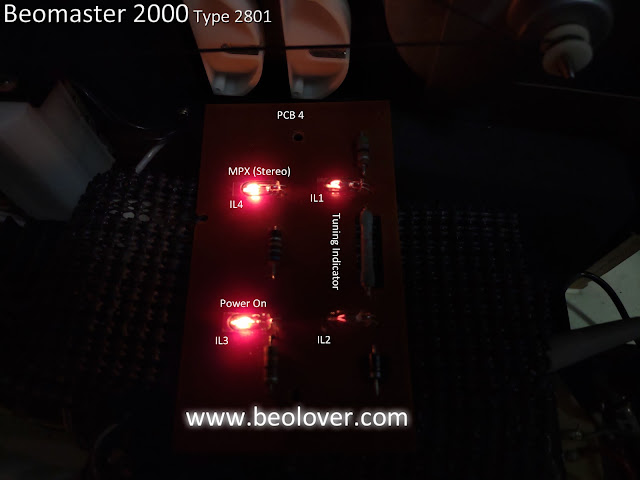In the last post I had made adjustments on the PCB 2 board with the FM Detect trimmer (2R28), the FM Tuning Indicator trimmer (2R31) and the FM Level trimmer (2R11).
The sound was good and the performance of the audio muting for FM, Phono and Tape sources was working.
There was an issue, however, with one of the FM tuning indicator lamps remaining on when a Phono or Tape source button was engaged.
Before making any more adjustments I decided to replace a couple more trimmers and check some more capacitors that are in the related circuit.
The capacitors checked out fine and I replaced trimmer 2R11 (FM Level) and 2R63 (+26V Reference Voltage). After that bit of work I set up my measurement probes to measure and re-adjust the trimmers involved with the FM tuning indicator lamps and the FM muting circuit.
Since I changed the 2R63 trimmer that controls the reference +26V I readjusted it first as it is used in the circuits I am working on.
Here is a look at the work area with all of the measurement probes attached.
After the +26V reference was set to 26.00 VDC I went through the FM signal balance and signal muting test points again.
When I powered on for the first time since adding a new 2R11 (FM Level) trimmer I discovered that the audio muting circuit was enabled when I selected Tape as the music source. I also saw that one of the two Tuning Indicator lamps was illuminated.
That makes sense to me now since a new 2R11, FM Level trimmer was installed and had not been adjusted yet.
The goal in the adjustment is to have a strong FM signal dialed in perfectly listening to the results by ear. When I determined an FM station was tuned as good as possible I made any adjustment up or down on the trimmers so the lamps (IL1 & IL2) were identically illuminated. I also had to recheck that neither IL1 or IL2 were illuminating when the Tape source is selected.
Being familiar with the procedure now it didn't take long to get the tuning balance and muting adjusted where I liked it. Here are the lamps with a good FM station tuned in.
Here are is the display when Phono or Tape are selected as the audio source.
I decided it would be a good idea to note the signal values I measured on the schematic to have as a reference guide the next time I restore a Beomaster 2000 (Type 2801).
The marked up schematic here shows the original service manual FM muting circuit along with the re-drawn circuit per the actual muting circuit on this Beomaster.
On the circuit I show the DC voltage values I measured when a Tape source is selected, a tuned in FM source is selected and an FM source with no station present is selected. The last scenario is when the FM muting circuit activates while the first two conditions result in no audio muting.
The FM reception is very good and the Tape source is working perfectly.
Overall I am happy with the adjustments.






No comments:
Post a Comment
Comments and suggestions are welcome!